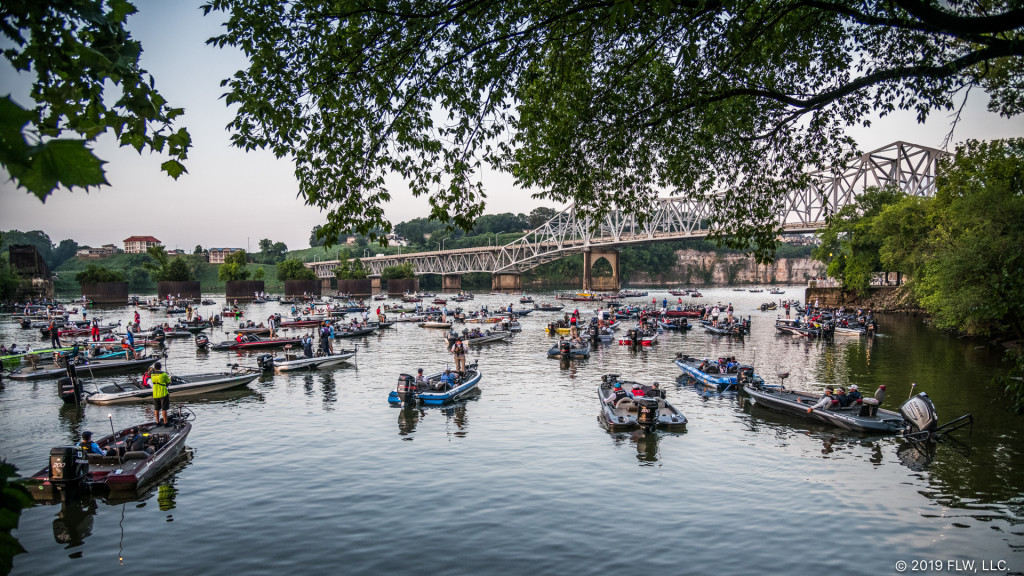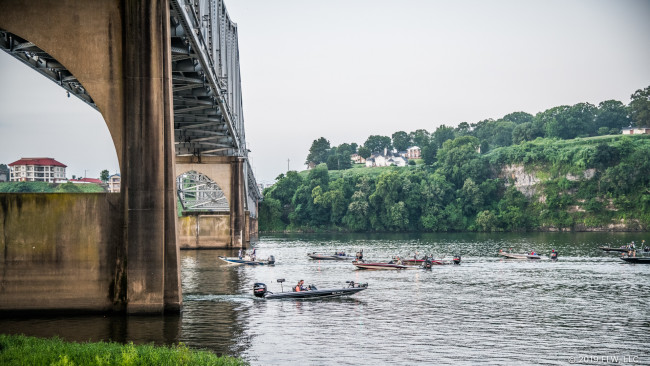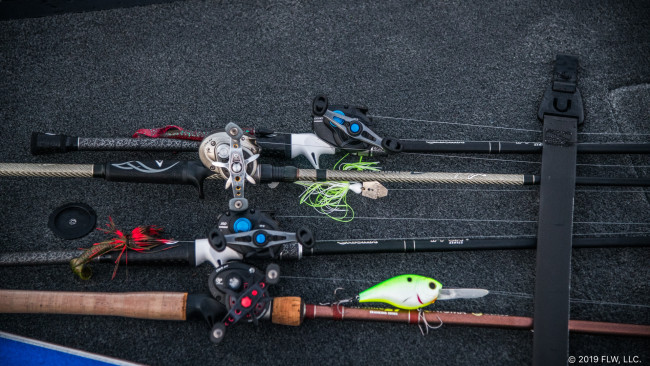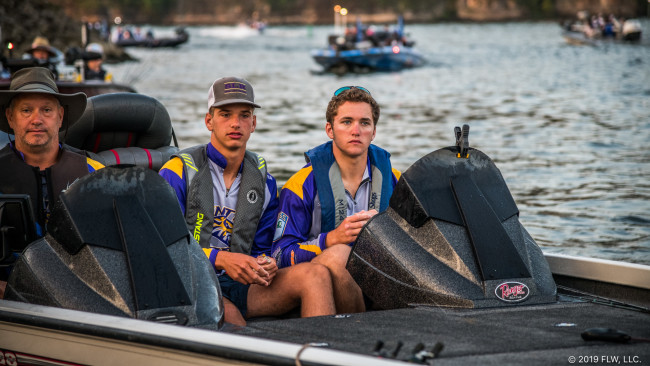High School Championships Underway
Pickwick could offer shallow and deep opportunities

Pickwick Lake’s diverse fishery will present a mix of opportunity and challenge for the field of 405 teams competing this week in the High School Fishing National Championship and High School Fishing World Finals presented by The Bass Federation and FLW.
The championships (details here) begin on Wednesday with two days of full-field competition for both events. The National Championship field is cut to the top 10 for day three, which is the final round of that tournament, and the winner is determined by heaviest three-day cumulative weight on Friday.
Each member of the winning team receives a $5,000 scholarship to the school of his or her choice, or a four-year $40,000 scholarship to Kentucky Christian University. All 10 finalists automatically advance to Saturday’s final round of the World Finals.
Teams are also competing for over more than $2 million dollars in scholarships and prizes at the World Finals.
The World Finals field is cut after two days to the top two teams from each state. Those anglers compete on Friday (when weights are zeroed) in the semi-final round.
Any teams that missed the cut in the National Championship or World Finals will compete on Friday in a separate second-chance round for a shot at making it back into the World Finals competition on Saturday.
Saturday’s field will consist of the 10 National Championship finalists, the top 10 teams from Friday’s semi-final round, and the next 10 teams (highest day-three weight) from the semi-final round and second-chance rounds combined. A Friday night party will include a Lucky Dog Last Chance Wildcard drawing for one team, not already qualified, to compete on day four – bringing the total to 31 teams. Weights are zeroed on the last day, and the World Finals winners are determined by the heaviest catch.
About the fishery
The eighth of nine Tennessee River reservoirs, Pickwick Lake was created in 1938 by Pickwick Landing Damat mile 207. Stretching 53 miles from the Wilson Dam tailwaters, Pickwick has an average depth of 21 feet, with its deepest reaches plunging to about 59.
Covering 43,100 acres, Pickwick features a mix of sand, gravel and rock bottom, with bridges, bluff walls, and occasional areas of shallow grass and shoreline wood. Traditionally, summer means offshore ledge fishing, but Pickwick will likely deliver a mix of opportunities in a wide range of depths.
This time of year, the mid- to lower end of the lake tends to get most of the attention, as it presents more of the traditional offshore ledge look. Currently, the Wilson Dam lock is closed, but while anglers are limited to Pickwick only, we may see some of the field running upstream from the McFarland Park takeoff to avoid the crowds.

Current conditions
Standing at about 413 1/2 feet, Pickwick’s water level is close to the normal pool level of 414. In recent days, Pickwick Landing Dam has been releasing approximately 40,200 to 40,800 cubic feet per second (CFS). Afternoons tend to see an uptick in power generation as folks return home and flip on the ACs, TVs and microwaves.
Day one of the tournament should see about the same release volume as earlier this week, but Thursday’s schedule shows an increase to 45,595 CFS.

Tactics in play
Jacob Bigelow of Shawano High School says he and his partner, Harmon Marien, of Northland Pines High School, have located the fish they need, but they may have to work at getting them to cooperate.
“The TVA is not pulling as much water as they were in last year’s tournament, and it’s not setting up exactly like I want it to. That’s making it a little tougher,” Bigelow says. “We found a couple of schools, and I think that if we play it out right and sit on a couple of schools we should be OK.”
As Bigelow explains, he would prefer to have his fish positioning on steeper structure and facing into the current, but he and Marien have been working on making the adjustments that will help them harvest the opportunity.
“We weren’t getting much on faster-moving baits, but we definitely found we could get bit on slower baits,” Bigelow says.
Sarah Morehead and Hunter Valerius, one of two teams in the tournament from McCracken County High School, the other being James Harper Burkeen and Austin Braboy, will also work offshore spots, but theirs will be a two-pronged game plan.
“There’s some new grass in the lake, and I think that’s putting us in a better position than last year’s tournament,” Morehead says. “I think there are some offshore patterns and some shallow patterns, and we’re going to try to target both. I feel like we have a pattern, but our pattern is different than everyone else’s.”
Valerius says that during practice, he and Morehead caught shallow fish in the mornings and then moved offshore by midday. The shallow fish responded to moving baits early, but slowing down with focused presentations proved most productive.
“I think the key will be to keep your head in the game,” Morehead adds. “I feel good about our game plan, so we just need to stick to that game plan and stay focused.”
Critical factors
– Weather –Tournament days will see air temperatures in the low to mid-90s, so hydration will be a must. Last night saw heavy rains, but the week’s forecast only calls for showers on Thursday. That’s always subject to change, and Valerius says he’s hopeful that the recent thunderstorms don’t affect how his shallow fish are positioned.
– Power generation schedules – Current is currency on TVA reservoirs, and when the water starts moving, or increases in strength, fish start biting. Anglers must remain alert and realize that long, stagnant periods can be interrupted by flurries of activity.
– Crowded waters – With more than 400 boats sharing Pickwick, competition for key spots will present a challenge for many. Timing is often key on TVA lakes, as the offshore fish tend to have narrow feeding windows. Current flow definitely influences this, but teams will have to plan well so they’re on “the juice” when conditions are right.
– Big bites – With a three-bass limit, as opposed to the common five-bass tournament bag, anglers should feel less pressure to generate quantity. Instead, the liberty to focus on the difference-makers could pay off big for some.

Dock Talk
Morehead says she believes a three-fish limit weighing 12 pounds would be a competitive daily performance. Bigelow expects more. He thinks 15 a day will put his team in contention.
Marien adds this: “The key will be focusing on getting big bites, instead of a five-fish limit. Being able to get those 4- to 6-pound bites will be the key. We did not get those bites in practice because once we saw a spot’s potential, we got out of there and saved it for the tournament.
“They’re definitely not huge schools; if I had to guess, I’d say 30 to 40 fish. That’s obviously plenty, but we’re focused on getting those big bites.”
Tournament details
Dates: June 19-22, 2019
Takeoff Time: 5:30 a.m. CT
Takeoff Location: McFarland Park, 200 Jim Spain Drive, Florence, Ala.
Weigh-In Time: 1:30 p.m. CT
Weigh-In Location: McFarland Park